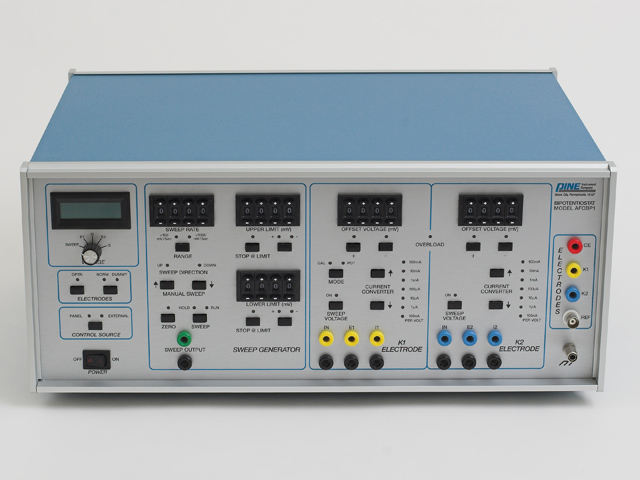Control of the CBP Bipotentiostat using either the traditional PineChem software package or the newer AfterMath software package requires installation of the proper version of the NIDAQ device driver on your computer. To select the proper NIDAQ version from the tables below, you need to know which version of the Windows operating system you are using and which interface board model you are using.
AfterMath
If you are using a PCI-6251, PCI-6259, PCI-6030E, PCI-6040E, PCI-MIO-16XE10, or PCI-MIO-16E-4 interface board with AfterMath, then download the appropriate device driver from the table below.
Operating System
Windows 10
Windows 8 (32 or 64 bit)
Windows 7 (32 or 64 bit)
Windows Vista (32 or 64 bit)
Windows XP (32 bit only)
Device Driver Version
NIDAQmx 17.1 (MAY 2017)
NIDAQmx 14.2 (NOV 2014)
NIDAQmx 14.2 (NOV 2014)
NIDAQmx 14.2 (NOV 2014)
NIDAQmx 8.9.5 (AUG 2009)
Legacy Note: If you are attempting to use the very old AT-MIO-16E-10 interface board with AfterMath, then you will need a Windows XP system equipped with a legacy ISA slot, you will need to install legacy NIDAQ 7.4.4 (MAR 2007), and you will need to click here for additional instructions.
PineChem
If you are using a PCI-6030E, PCI-6040E, PCI-MIO-16XE10, PCI-MIO-16E-4, AT-MIO-16E-10, or AT-MIO-16H-9 interface board with PineChem, then download the appropriate device driver from the table below. You should also click here for additional instructions.
Operating System
Windows XP (32 bit only)
Windows NT
Windows 2000
Windows 98
Windows 95
Device Driver Version
legacy NIDAQ 7.4.4 (MAR 2007)
legacy NIDAQ 7.4.4 (MAR 2007)
legacy NIDAQ 7.4.4 (MAR 2007)
legacy NIDAQ 6.9.2 (FEB 2002)
legacy NIDAQ 6.9.2 (FEB 2002)
PineChem Version
PineChem 2.8.0H
PineChem 2.8.0H
PineChem 2.8.0H
PineChem 2.8.0H
PineChem 2.7.9A
Legacy Note: If you are attempting to use the very old AT-MIO-16E-10 interface board with PineChem, then you will need a computer system equipped with a legacy ISA slot. You will need to install the appropriate version of the legacy NIDAQ device driver as listed above, and you will need to click here for additional instructions.
Legacy Note: If you are attempting to use the very old AT-MIO-16H-9 interface board with PineChem, then you will need a Windows 95/98 computer system equipped with a legacy ISA slot. You will need to install the appropriate version of the legacy NIDAQ device driver as listed above.
Installation
In general, installation of the driver is a simple matter of unzipping the device driver package to a temporary folder on your hard drive and then clicking on the “setup.exe” file.
IMPORTANT SECURITY NOTE: The NIDAQ driver should always be installed from a Windows user account which has administrative privileges. If the user who will routinely be using the AFCBP1 Bipotentiostat does not have an account with administrative privileges, then special steps must be taken to assure that the user is granted access to certain installation folders. Click here for more details about this issue.
Activation
After you have installed the device driver on your computer (and after you have physically installed the interface board inside your computer), you should run the Measurement & Automation Explorer (MAX) utility. The MAX utility is installed on your desktop when you install the NIDAQ device driver.
Using the MAX utility, look inside the “Legacy NIDAQ Devices” folder and make certain that your interface board appears. The interface board usually appears as a “PCI-MIO-16E-4” board in the list of legacy devices. It is usually assigned a device number equal to one (1).
Additional Resources
Related Hardware Links: CBP Bipotentiostat, Interface Boards
Related Software Links: AfterMath, PineChem, NIDAQ Device Driver





Comments: